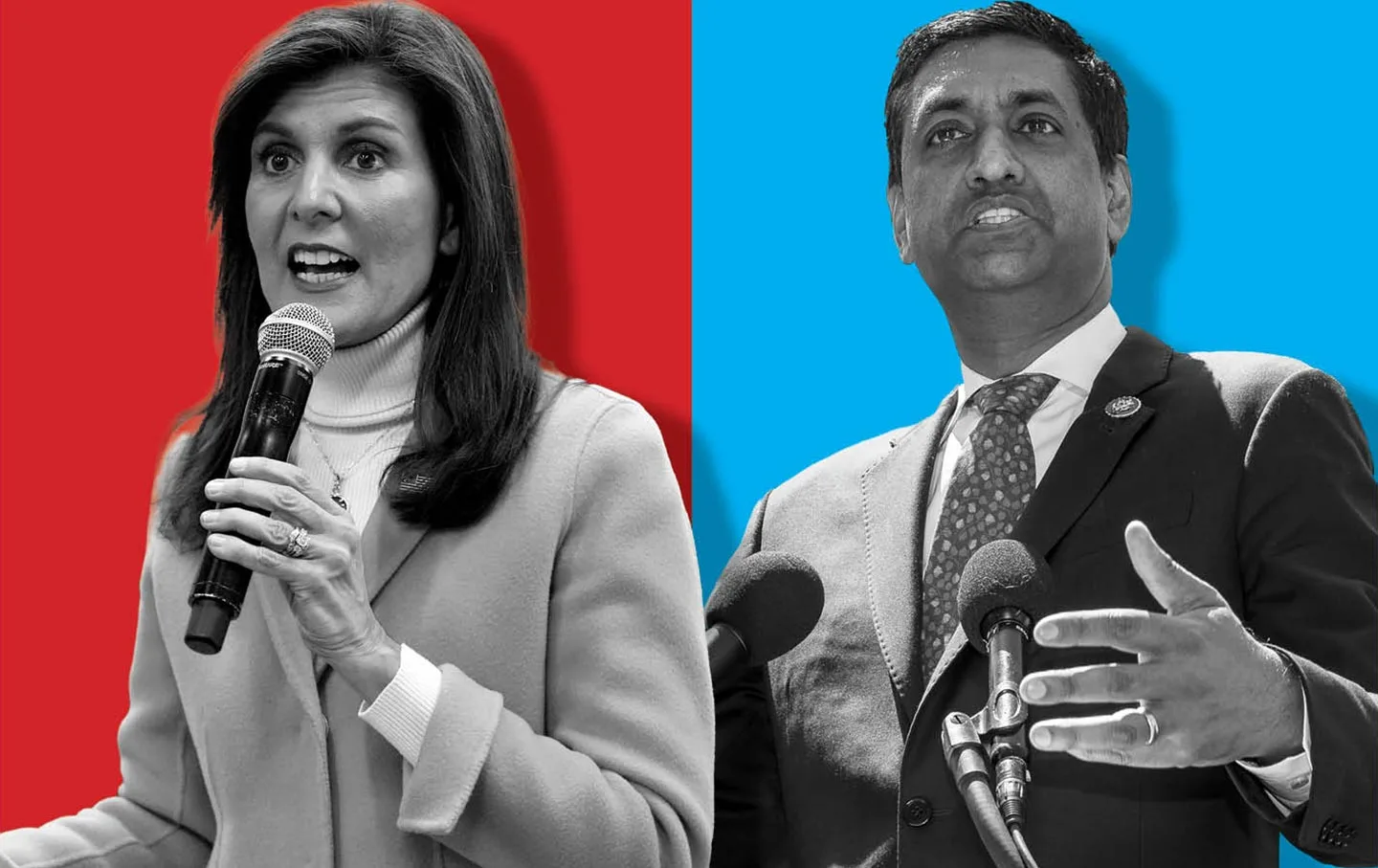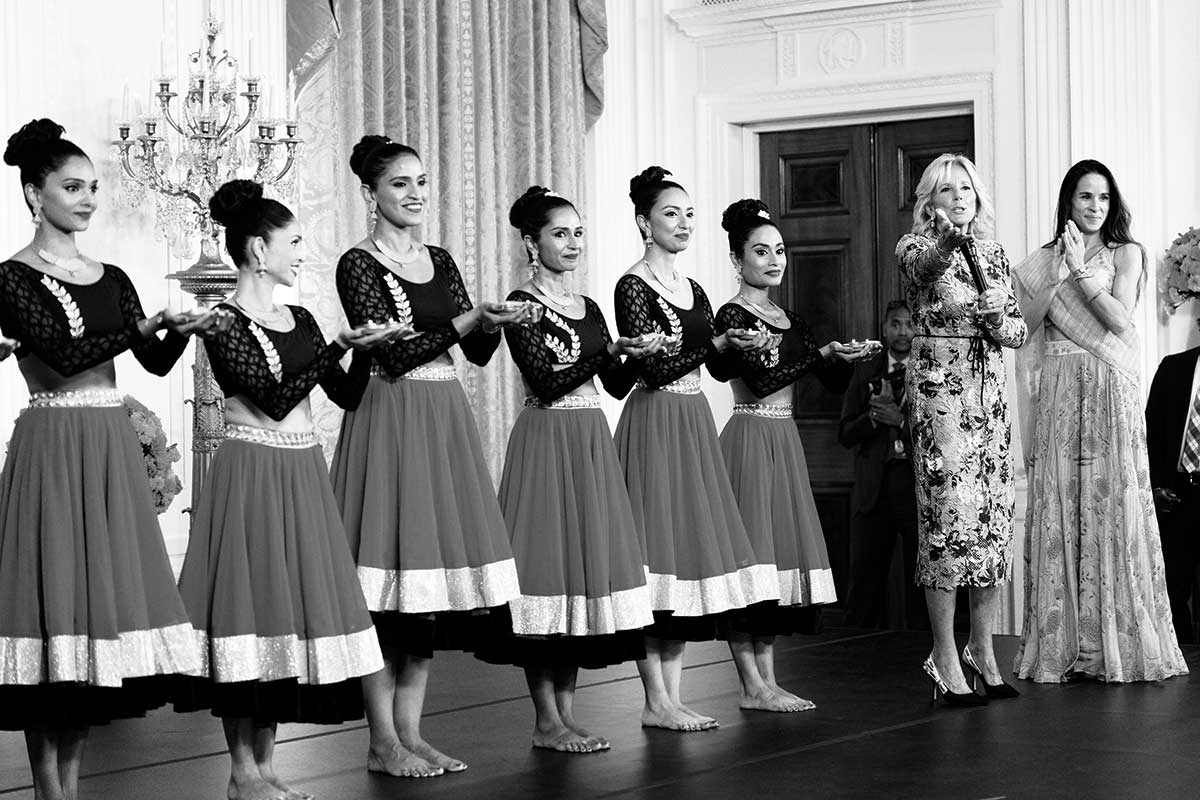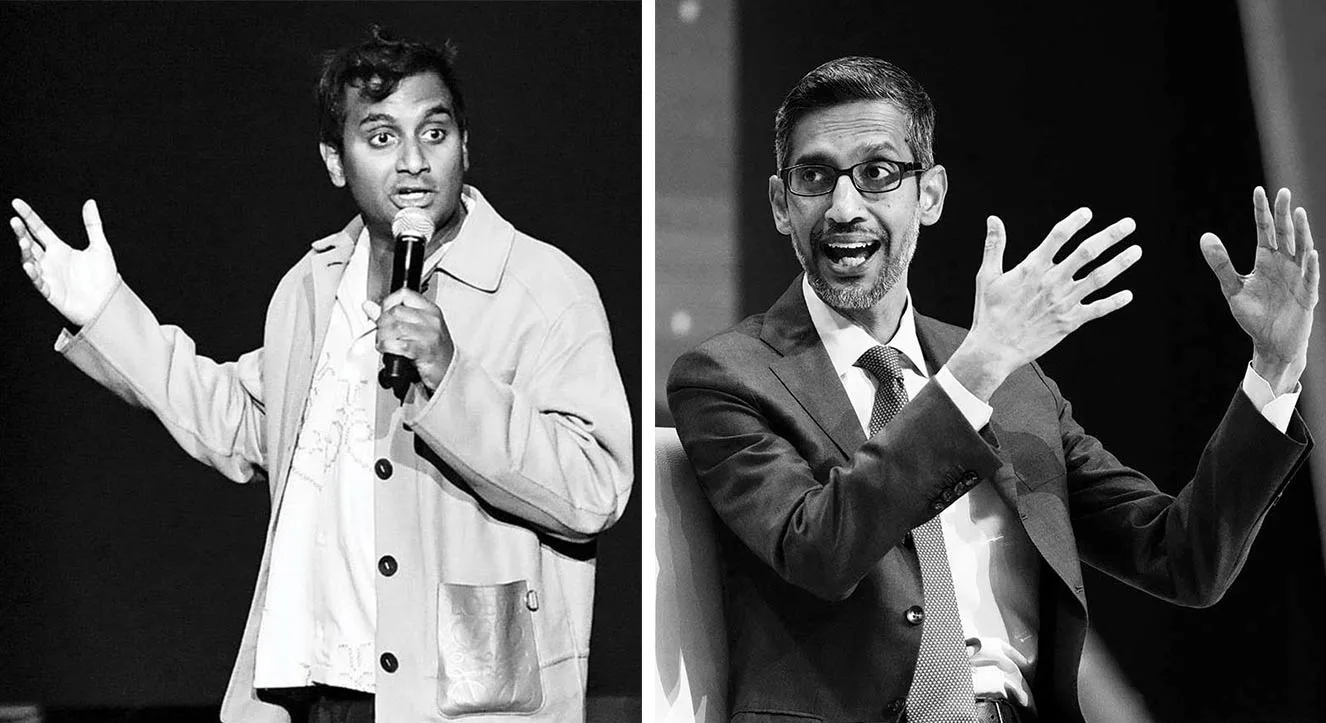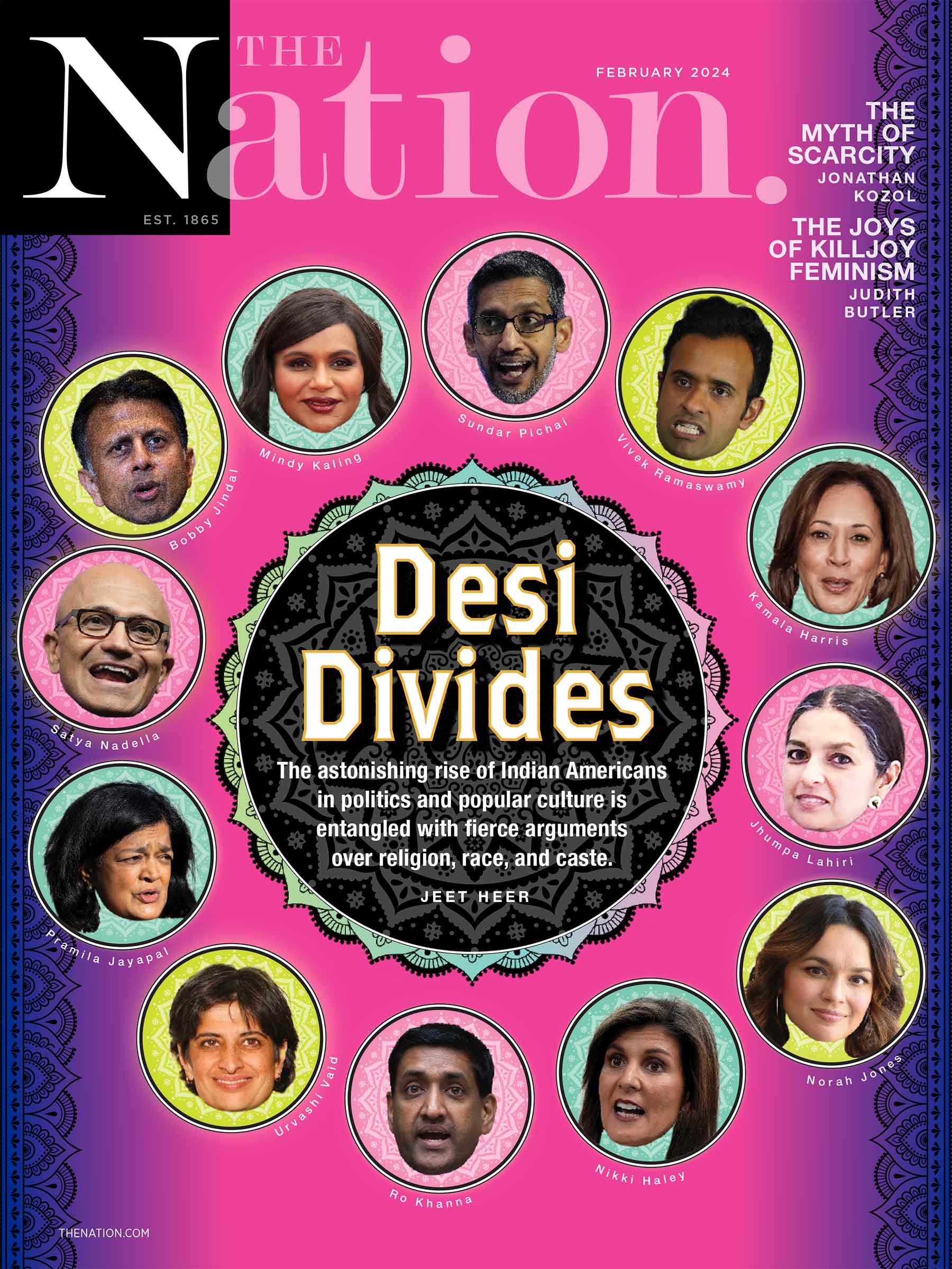
You can tell that an ethnic group is really flourishing in the United States when they start to produce prominent xenophobes and racists, particularly of the anti-Black variety. The trajectory from victim to victimizer is one of the surest markers of upward social mobility. In 1993, Toni Morrison ruefully noted in Time magazine that assimilation means immigrants must join “freely in this most enduring and efficient rite of passage into American culture: negative appraisals of the native-born Black population.” In the 19th and early 20th centuries, the ramparts of white supremacy were maintained by old-school Protestants who organized groups like the Know Nothings and the second Ku Klux Klan to terrorize not just people of color but also Irish Americans, Italian Americans, and Jewish Americans. In the 21st century, the most prominent bigots of the MAGA right are the descendants of these groups: figures like Steve Bannon, Rudy Giuliani, and Stephen Miller.
One of the few intriguing developments in the 2024 Republican primary is fresh evidence that Indian Americans—or at least a significant cohort of them—might join this longstanding trend. The two candidates who have made the biggest unexpected splash in the GOP primaries are the tech entrepreneur Vivek Ramaswamy and former South Carolina governor Nikki Haley. While Donald Trump has long dominated the race, Ramaswamy’s campaign enjoyed a brief surge in August, and as this issue went to press, Haley was still riding a better—and longer—uptick. Both of these candidates of Indian descent are only nominally Trump rivals; given his near lock on the nomination, they’re more plausibly auditioning to be members of a future Trump administration, perhaps as vice president, by showing that they can sell the MAGA platform in a stylish new form. In so doing, they are fully participating in the “rite of passage into American culture” that Morrison wrote about 30 years ago.
Ramaswamy has repackaged Trumpism in his persona as a brash young businessman not afraid to offend. During the GOP’s presidential primary debate on December 6, Ramaswamy proclaimed that the “great replacement theory” is “not some grand right-wing conspiracy theory, but a basic statement of the Democratic Party’s platform.” The racist fantasy he was defending is that non-white immigrants are being brought into the United States to replace white Americans. But then Ramaswamy’s entire campaign was built on pandering to racist sentiments, such as when, at a Republican fundraiser in August, he reassured the audience: “I’m sure the bogeyman white supremacist exists somewhere in America. I’ve just never met him. Never seen one, never met one in my life, right? Maybe I’ll meet a unicorn sooner. And maybe those exist too.”
In contrast to Ramaswamy’s flame-throwing approach, Haley has downplayed racism in a more genteel manner, such as her refusal in late December to mention slavery as a cause of the Civil War. As she does so often, Haley later backpedaled when challenged.
But then Haley has often tried to play both sides of the peculiar institution. As governor of South Carolina, she was a strong supporter of keeping the Confederate flag flying over the state capitol. Only after a neo-Nazi killed nine African Americans at a church in Charleston did Haley finally come out against the flag—even as she continued to refer to it as “a symbol of respect, integrity, and duty.”
For many Indian Americans—a community that overwhelmingly votes for Democrats—the rise of candidates like Ramaswamy and Haley is a good news/bad news joke. The good news is that Indian Americans, whose prominence in American public life is relatively new, are now fielding multiple political candidates on the national stage. The bad news is that two of the most visible of these openly embrace the most rancid forms of white supremacy, including neo-Nazi talking points and neo-Confederate historical mythology.
The rapid rise of Indian Americans is one of the most startling domestic events in 21st-century America, and one of the great success stories of liberal multiculturalism. Even Joe Biden, in his awkward way, has taken notice. In 2021, Biden was talking to Swati Mohan, the NASA scientist who was then overseeing the landing of the Mars rover Perseverance. Mohan was born in Karnataka, India, in 1983, a fact that inspired Biden to remark: “It’s amazing. Indian—of descent—Americans are taking over the country: you, my vice president [Kamala Harris], my speechwriter Vinay [Reddy]…. You guys are incredible.”
By some measures, Indian Americans are now the most economically successful ethnic group in America, an almost complete reversal from a century earlier, when they were a tiny, impoverished minority near the bottom of the social pecking order. Indian Americans have made their names in countless fields, from tech (Microsoft CEO Satya Nadella, Google CEO Sundar Pichai) to science (Nobel laureate in chemistry Venkatraman Ramakrishnan) to literature (Pulitzer Prize–winning novelist Jhumpa Lahiri) to journalism (Ali Velshi) to music (Norah Jones, the daughter of Ravi Shankar) to comedy (Mindy Kaling, Aziz Ansari, Hasan Minhaj).
Given the success of Indian Americans in so many walks of life, it may seem unfair or masochistic to see any import in the prominence of racist hustlers like Ramaswamy and Haley (or their intellectual forebear, the far-right troll Dinesh D’Souza, notorious for his anti-Black venom). One could further point out that in 2020, the overwhelming majority of Indian Americans voted for Joe Biden, and the ranks of liberal Indian American politicians, headed by Vice President Harris, are large and growing, with five Indian Americans currently in Congress: Ami Bera, Pramila Jayapal, Ro Khanna, Raja Krishnamoorthi, and Shri Thanedar—all Democrats. As head of the Congressional Progressive Caucus, Jayapal is the most influential Indian lawmaker in America, second only to Harris in prominence among elected officials.
Yet it would be a mistake to dismiss Ramaswamy and Haley as outliers. Even as the majority of Indian Americans currently sit comfortably within the technocratic liberalism of Biden and Harris, a significant minority are being tugged toward a very different politics.
Race remains the great dividing line. Within America’s evolving racial system, Indian Americans have long held a curious liminal position, able to shift radically. The great Black radical W.E.B. Du Bois, believing that the color line bisects the globe as well as American society, was keenly alert to the complex status of Indians both in their native country and in the diaspora. Reflecting on his friendship with the Bengali poet Rabindranath Tagore, Du Bois wrote:
Peculiar circumstances have kept Indians and American Negroes far apart. The Indians naturally recoiled from being mistaken for Negroes and having to share their disabilities. The Negroes thought of Indians as a people ashamed of their race and color so that the two seldom met. My meeting with Tagore [in 1929] helped to change this attitude and today Negroes and Indians realize that both are fighting the same great battle against the assumption of superiority made so often by the white race.
Du Bois, as he did so often, proved to be prophetic: There remains a division among Indian Americans between those who are loath to associate with Black Americans and those who see themselves allied with Blacks and other non-white groups in a common battle against white supremacy. With India as an independent country that is now under the control of the right-wing Hindu nationalist Narendra Modi, this fissure is further complicated by issues of caste and religion. The Indian American community is deeply polarized. And because this community is rapidly growing both in size and political power, these divisions will have far-reaching consequences.
To borrow the language of Du Bois, the color line continues to define the 21st century. The question for Indian Americans is: Which side of the line do they fall on?

When Joe Biden was born, in 1942, Indian Americans were a rare sight, a result of racist laws dating back to the 19th century and culminating in the Immigration Act of 1924, which set a severe quota on migrants from nations outside of Western Europe and the British Isles. The 1940 census listed 2,405 Indian Americans. There were likely several hundred more undocumented Indians, often smuggled into the country by the revolutionary and anti-colonialist Ghadar Party, the world’s first Indian-created communist movement, which had improbably formed in Oregon in 1913. The early cohorts of Indian Americans tended to be working-class, often farm laborers—and politically radical.
Although the community was small, people from the Indian subcontinent had been in the United States for many generations. A significant cohort arrived in the 18th and 19th centuries on whaling ships and Yankee clippers. In their maritime travels, some of them surely came across a scribbling seaman named Herman Melville, who included a South Asian harpooner in Moby-Dick, a Zoroastrian named Fedallah. (The “hair-turbaned Fedallah,” Melville wrote, “remained a muffled mystery to the last.”) Some of Fedallah’s real-life counterparts settled in New England, where they tended to marry African American women and disappear as a distinct immigrant group. The Sikh farm laborers who immigrated to California in the 19th century similarly assimilated through marriage to Mexican Americans.
Popular
“swipe left below to view more authors”Swipe →
These Indian American pioneers formed a small, marginalized working-class community whose numbers fluctuated in the low thousands. One academic study notes that in the 1940 census, “the education level for Asian Indians was the lowest of all reported racial and ethnic groups.” In 1914, California Congressman Denver Church voiced a common sentiment of the era when he said at a hearing, “Those of us who come into contact with the Hindus, and I think it is universal, regard them as a menace…they cannot read our language any more than a horse can.” In the landmark case United States v. Bhagat Singh Thind (1923), the Supreme Court ruled that although Indians were classified as “Caucasian” by some academic authorities, in the eyes of “the common man” and of the law they were non-white. This dual category of being both non-white and Caucasian speaks to the way South Asians confounded American racial understanding. To put it another way, Indian Americans had the potential to go in both directions: to become either Caucasian or non-white, depending on arbitrary rules set by white society.
All of this changed with the Immigration Act of 1965, a pivot point in American demographic history. Forged by the interconnected pressures of the civil rights movement (which bristled at the racist 1924 Immigration Act) and Cold War liberalism (which in a bout of post-Sputnik anxiety gave priority to rapidly expanding the cohort of highly educated Americans), the new law opened the door to credentialed immigrants of many nations.
Along with other newly independent countries, India was well-positioned to become a net exporter of postgraduate professionals. British rule had already created an educational infrastructure with robust English-language instruction. And as part of its development strategy, India invested heavily in higher education, with a particular emphasis on science and technology. The acronym STEM (science, technology, engineering, and mathematics) wasn’t coined until 2001, but in the late 1940s India was already aiming to become a STEM power under Jawaharlal Nehru, its first prime minister.
Although Nehru’s education policy was social democratic in its intent, the entrenched elite were the initial beneficiaries, with the Brahmin caste being overrepresented. This caste was feeling increasingly insecure in an independent India, as the new democratic norms undermined its traditional privileges. Immigration offered a chance to escape this less hospitable environment. As Indian universities started to produce a superabundance of doctors, engineers, scientists, and academics, the stage was set for a major brain drain.
The first immigrants who benefited from the opening of Cold War America leaned heavily toward the STEM elite. They included Kamala Harris’s mother (Shyamala Gopalan, a biologist who immigrated in 1958); Nikki Haley’s parents (Ajit Singh Randhawa and Raj Kaur Randhawa, a biology professor and a public school teacher, who arrived in 1969); and Vivek Ramaswamy’s parents (V. Ganapathy Ramaswamy and Geetha Ramaswamy, an engineer and a geriatric psychiatrist, who immigrated in the 1980s).
Aside from Gopalan, who came earlier, all of these families benefited from the Immigration Act of 1965. Part of Haley’s warped racial politics is her denial of this history. In 2016, she asserted that “we’ve never in the history of this country passed any laws or done anything based on race or religion.” This is, of course, absurd. It’s not just pandering to white fantasies of a non-racist past; it’s also a way of denying that Haley and her family owe anything to the Black-led civil rights moment. To acknowledge such a debt would undermine Haley’s pretense that she’s an American success story whose rise was due to her own gumption and owes nothing to anti-racist politics.
Haley and other Indian American politicians rode a wave of immigrants—often professionals in fields like medicine and engineering, as well as entrepreneurs who found a niche in the hotel industry—that quickly dwarfed the existing, barely perceptible Indian presence. The rise of Silicon Valley in the 1990s spurred another surge of Indian immigration. The 2020 census records 4.4 million Indian Americans, up more than 50 percent from the 2.8 million in 2010.
These statistics need to be qualified, since the phrase “Indian American” is itself a semantic quagmire. The Hindu nationalists of Prime Minister Narendra Modi’s ruling Bharatiya Janata Party are in fact hostile to the very name India, which they see as too inclusive and secular. Within the BJP, there is a movement to rename the country Bharat, a word from Hindu scripture meaning “one who pursues light.” The subcontinental nations that share India’s history of British imperial rule—as well as many cultural traditions—include Pakistan, Bangladesh, and Sri Lanka. The Carnegie Endowment, which has published extensive studies of Indian Americans, reports that only 80 percent of the foreign-born population that describes itself as Indian in the 2020 US census were born in India. According to one Carnegie study, “6 percent were born in either Bangladesh or Pakistan. The remainder of the sample hails from a range of countries stretching from the United Kingdom to Trinidad & Tobago and Kenya.”
This terminological muddle is made worse by the fact that because of the world-historical blunder of Christopher Columbus, “Indian American” is also used to describe the Indigenous nations of the Western Hemisphere. In contrast to the blurriness of that phrase, “South Asian” and “desi” (from the Sanskrit word for “country”) have the virtue of describing the actual scope of the subcontinental diaspora. Especially among second-generation immigrants, self-identification defined by national borders tends to give way to a broader awareness of a South Asian or desi identity. But “Indian American” remains the term used by political scientists, because it can be most easily grounded in census data.

However one defines them, Desis are emerging as a decisive voting bloc. The same Carnegie project notes that “rapid population growth means that the Indian American voting population is reaching a degree of newfound electoral significance. Indeed, the Indian American eligible voter population has grown to be larger than several of the victory margins seen in the 2016 presidential election, particularly in battleground states such as Michigan, New Hampshire, and Pennsylvania.” A recent New York Times article added Florida and Nevada to the list of states where Indian American voters were “large enough to make a difference at the margins.”
In other words, it’s likely that Indian American voters, who lean heavily toward the Democrats, swung the 2020 election to Biden, and they will almost certainly be equally pivotal in future presidential races. Currently, desis vote for the Democratic Party in proportions similar to Jewish Americans. But imagine a world in which desis voted more like wealthy white Americans—a group they are sociologically close to. In such a world, all the swing states could go Republican. For the GOP, the political potential of Ramaswamy and Haley lies in the fact that they might trigger such a shift.
Aside from swelling the voter rolls, Indian Americans are increasingly taking leadership positions in national politics—hence the rise of figures like Harris, Jayapal, and former Louisiana governor Bobby Jindal as well as Ramaswamy and Haley. The reason for this blossoming of political talent is structural: The highly educated cohort created by Indian public policy and the US Immigration Act of 1965 has been succeeded by an American-born generation that is at ease in elite social spaces.
To this structural explanation, a cultural one might be added. Karthick Ramakrishnan, a professor of public policy at the University of California, Riverside, told The New York Times that the long-standing tradition of English education among the elite in India created a language fluency that might have aided their rise in politics (and, one could add, in culture). According to the 2016 study The Other One Percent by Sanjoy Chakravorty, Devesh Kapur, and Nirvikar Singh, Indians in America are an “outlier” in terms of their education and worldly achievement, constituting “arguably the richest and most economically successful group in one of the richest [countries] and unarguably the most powerful country in the world.”
Polling conducted by Carnegie shows that in 2020, Indian Americans preferred Biden to Trump by a factor of more than three to one: 72 percent voted for Biden, compared with 22 percent for Trump. They are skeptical of Republicans, seeing the party as hostile to immigrants and too beholden to evangelical Christianity. (Only 10 percent of Indian Americans are Christian; 54 percent are Hindu, 13 percent are Muslim, 8 percent claim other faiths, and 16 percent declare no religion.) On the issues and in terms of ideological self-identification, Indian Americans lean left: 47 percent identify as liberals, 29 percent as moderates, and 23 percent as conservatives.
Beyond how they stand on particular issues and candidates, Indian Americans have found a home in the United States as exemplars of liberal meritocracy—though even within that framework, there’s long been a significant component of left-wing activism, embodied by figures like the late Urvashi Vaid, a pathbreaking LGBTQ rights activist. As the historian and journalist Vijay Prashad—an often biting social critic of his community—told me, “These are technocratic people. They believe that history moves through a public policy document.” This worldview also makes them a good fit for Joe Biden’s Democratic Party.
No wonder, then, that Biden thinks Indian Americans are “incredible.” They seem like a Democrat’s dream come true: a fast-growing, thriving, politically engaged, and hyper-educated community that is solidly behind the Democratic Party.

But things that seem too good to be true usually are. Liberal technocracy is a brittle ideology, even among its beneficiaries. In reality, Indian Americans are not immune to the centrifugal forces of identity and inequality that are dividing both the United States and India. Modi’s version of Hindu nationalism is itself polarizing not just India but the diaspora. Indian Americans are both rising up and fracturing on issues of religion, race, and caste.
In early November, Biden and Harris got a taste of these sharpening divisions when they invited South Asian celebrities to the annual White House Diwali celebration. Diwali is the Hindu festival of light, a holiday also celebrated by non-Hindus in India in the way Thanksgiving and Christmas are celebrated by non-Christians in the West. Among those invited to the event was the Sikh Canadian poet Rupi Kaur (Sikhs have their own version of Diwali called Bandi Shor Divas). But Kaur declined to attend, citing Biden’s “support of the current atrocities against Palestinians” and adding, “I will not allow my likeness to be used in whitewashing the administration’s actions.” Kaur’s boycott was soon joined by other desi luminaries, including the actress Richa Moorjani, the investor Anjula Acharia, the filmmaker Shruti Ganguly, and the media outlet Brown Girl Magazine. Significantly, the divide wasn’t along religious lines but rather political ones. The boycotters were not Muslims; instead, they reflected the long-standing passion for the Palestinian cause among desi progressives of all faiths.
The Diwali boycott represented one side of the fracturing of liberal technocracy, as solidarity with Palestinians has eroded support for Biden among some desis. Conversely, right-wing Indian Americans argue that Israel’s war in Gaza should be cheered—and even emulated. Asked about the Israel/Palestine conflict at the November GOP debate in Miami, Haley answered that the goal should be to “finish them [Hamas]” and “support Israel with whatever they need, whenever they need it.” Not to be outdone, Ramaswamy said, “I would tell [Benjamin Netanyahu] to smoke those terrorists on his southern border, and then I’ll tell him, as president of the United States, I’ll be smoking the terrorists on our southern border.” Turning the US-Mexican border into a smoking ruin like Gaza might not appeal to everyone—but it certainly shows that Indian Americans aren’t immune to xenophobia.
Haley and Ramaswamy could both be described as illiberal technocrats. Haley’s political pitch draws from her family’s rise in the United States and her own résumé, with an emphasis on her ability to work with the business community, her governorship of South Carolina, and her tenure as a UN ambassador. Ramaswamy also casts himself as proof of American meritocracy, playing up the stereotypical success of Indian Americans in the tech sector. In both cases, this “model minority” narrative also plays to anti-Black sentiment, with African American politicians like Barack Obama accused of creating a victim mentality that is belied by immigrant success.
Haley and Ramaswamy both have the potential, if they joined a presidential ticket, to swing some Indian American votes to the Republican Party. As people of color who grew up in America, they are both adept code-switchers who know how to present different faces to different audiences. (In that capacity, they represent an advance over Bobby Jindal, who tended to vehemently deny his Indian identity and assert that he was an unhyphenated American.) Born into a Sikh family, Haley converted to her husband’s Methodism. Sometimes she presents herself as proof that immigrants can flourish in America and speaks of the racism she experienced when growing up; at other times, she gives greater weight to her identity as a Christian. Ramaswamy is a genuine pioneer in being a conservative desi Republican running a national campaign while affirming a Hindu identity. He has tried to square this circle by emphasizing that his Hinduism is perfectly compatible with conservative Christianity, since they share an antipathy toward cultural liberalism—hence Ramaswamy’s repeated assertion that there are only two genders.
Taken together, Haley and Ramaswamy represent something new on the Indian American right: candidates who seem to have the ability to straddle the racial divide. To use Du Bois’s terminology, they are aligned with the white side of the color line. And they are both trying to pull the Indian American community in that direction.
Sara Sadhwani, a political scientist at Pomona College, has polled Indian Americans to test whether ethnic identity could overcome partisan identity. She found that “nearly 60 percent…said that they would support an Indian American candidate running for political office regardless of their party affiliation, which is pretty strong.” Milan Vaishnav, a senior fellow at the Carnegie Endowment, observed that post-2020, there has been “some rightward movement among Asian Americans as a whole,” especially on issues like crime and inflation. He thinks Haley’s persona as a more establishment Republican helps her make “some inroads” among Indian Americans. Devesh Kapur, a political scientist at Johns Hopkins University, concurs: “My instinct would be that if Nikki Haley becomes more prominent, there will be greater support for her from the community, no doubt about it,” he told me.
Naindeep Singh, the executive director of the Jakara Movement, which organizes primarily among the Sikh community, sees a splintering of the desi diaspora on a host of issues such as gender (with some young desis resenting the overturning of patriarchal norms and starting to turn to right-wing voices) and caste (a problem that bedevils many Indian communities, including Hindus and Sikhs).
The early immigrants of the post-1965 generation tended to be high-caste, but as the desi community has expanded, it has also diversified. In the United States, as in India, the rise of Dalit militancy has been met with a right-wing backlash. Recently, there have also been high-profile accusations of discrimination against Dalits in Silicon Valley. Facing pressure from Brahmin donors, Democratic politicians like California Governor Gavin Newsom have sandbagged anti-caste measures.
The authoritarian Hindu nationalism of Narendra Modi is also fracturing the Indian diaspora. As a Carnegie report notes, “Indian Americans hold broadly favorable views of Modi. Nearly half of all Indian Americans approve of Modi’s performance as prime minister.” But Modi’s hostility toward religious minorities such as Muslims and Sikhs makes him a deeply divisive figure. In the fall of 2023, evidence emerged that his government was carrying out assassination attempts against Sikh separatists in a variety of countries, including the United States, Canada, and Pakistan. This is an explosive issue that sharply separates Modi’s Hindu supporters from his critics, who include secular progressives as well as religious minorities.
Du Bois asked which side of the global color line Indians will fall on. We can add that there is now a global caste line as well as a global religious one. These lines divide the desi diaspora as well as India itself.
It’s unlikely that Indian Americans will move en masse to the Republican Party anytime soon. But a move to the right doesn’t necessarily involve a partisan shift. The right-wing currents that emerged among American Jews in the 1960s fostered a neoconservatism that manifested itself among both Democrats and Republicans. Vijay Prashad suggests something similar is happening with Indian Americans: the birth of a desi neoconservatism, complete with a Hindu lobby that rivals the Israel lobby in terms of its political clout. The ultimate legacy of Ramaswamy and Haley might be that they help accelerate the emergence of this desi neoconservatism, a phenomenon that will challenge liberal technocracy for years to come.




